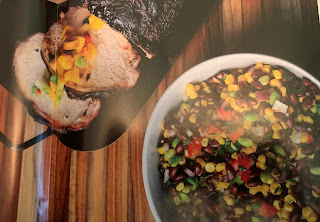Kansas soy finds a place on the plate in issue 4, vol 77, 2021, of KANSAS! Magazine. The Taste section features "Soy in the mIx", my article explaining the role of soy in Kansas agriculture, in the market plate and on the plate. Charlene Patton, consumer media specialist for the Kansas Soybean Commission shares her insight and shares her "joy of soy" as well as two soy-based recipes.
 |
| Photo from the magazine of the two featured soybean dishes. |
Rotisserie Pork Loin Roast Yield: 8 servings
Soy flour is a component is the rub used on the pork roast. The flour, made by grinding roasted soybeans into a powder, retains the bean’s nutritious fiber and oil, and adds a rich, nutty flavor.
INGREDIENTS
4-pound boneless pork loin roast
2 tablespoons brown sugar, packed
1 tablespoon soy flour blend*
2 teaspoons ground cumin
2 teaspoons smoked paprika
2 teaspoons kosher salt
¼ teaspoon ground cinnamon
2 tablespoons vegetable (soy) oil
DIRECTIONS
1. Pat roast with paper towel to remove moisture. Use butcher string to tie if needed. Place meat on rotisserie spit rod and secure with skewers.
2. In small bowl combine brown sugar, soy flour blend, cumin, smoked paprika, kosher salt and cinnamon.
3. Brush meat with vegetable (soy) oil and rub with spice mixture to cover meat on all sides. Place rod in motor over indirect heat with coals on each side. A drip pan in center will catch juices. Roast for 30 to 60 minutes depending on temperature of coals. Check for doneness with a meat thermometer with 145°F for medium.
4. When done remove roast from grill and remove rotisserie spit rod; cover roast with foil; let roast rest for 15 minutes. Carve into slices.
*Soy flour blend is 7 cups all-purpose flour combined with 1 cup soy flour.
Nutritional Information per serving: one serving (237 g)
Calories 370; Total Fat 22g (9 g sat fat); Cholesterol 120 mg; Sodium 1,142 mg; Total Carbs 5 g; Protein 42 g; Fiber 1 g
Black Soybean Corn Salad with Citrus Dressing Yield: 8 servings
This recipe features both edamame and black soybeans. Edamame are harvested when the beans are still green and sweet tasting; they are generally available in the freezer sections of mainstream grocery stores. As soybeans mature in the pod, they ripen into hard, dry beans; although most are yellow, there are also brown and black varieties. Cans of black soybeans are most often found in specialty markets.
INGREDIENTS
1 can (15 ounces) black soybeans, drained and rinsed
1 cup frozen corn, thawed
½ cup shelled edamame, cooked
½ cup chopped red bell pepper
½ cup chopped red onion
¼ cup chopped fresh cilantro
1 tablespoon orange zest
1 teaspoon lime zest
½ cup orange juice
1 tablespoon lime juice
¼ cup vegetable (soy) oil
¼ teaspoon salt
DIRECTIONS
1. Combine in mixing bowl black soybeans, corn, edamame, bell pepper, onion and cilantro.
2. For dressing, grate peel of orange and lime and place zest in container that has a tight fitting lid. Add orange juice, lime juice, vegetable (soy) oil and salt; close with lid and shake to mix.
3. Pour dressing as desired over vegetable mixture; refrigerate to chill.
Nutritional Information per serving: one serving (125 g)
Calories 152; Total Fat 10g (1g sat fat); Cholesterol 0 mg; Sodium 93 mg; Total Carbs 12 g; Protein 6g; Fiber 4 g
1. How many years ago did the Chinese discover the soybean?
1000 years 3000 years X 5000 years
Soybeans were discovered more than 5,000 years ago, growing wild on the windy plains of eastern Asia. According to Chinese tradition, soybeans were named as one of the five sacred crops by Emperor Sheng-Nung who reigned 5,000 years ago.
2. When did soybeans come to the United States?
1400 1500 1600 1700 X 1800
Soybean are a relatively new crop to the United States compared to wheat and corn. The first soybeans came to American in trading ships returning from China in the early 1800’s. Soybeans were used as an inexpensive heavy material in the ship for stability & were tossed overboard upon arrival. In 1879 scientists at agricultural experimental stations planted and harvested soybean crops. By 1898, USDA was conducting tests on soybeans and distributing seeds to farmers to grow for animal feed.
3. Check the foods that may contain soy ingredient.
Margarine / Peanut Butter / Beef Bouillon /Candy Bar / Canned Soup / Vegetable oil
ALL or the above. Read the label! 80% of the food items in the grocery store contain some type of soy ingredient. Soy oil is the natural oil extracted from the whole soybean. 75% of the vegetable oil sold is soybean oil.
4. Most soybeans in Kansas are used are used for animal agriculture?
X Yes No
97% of soybeans are used for soybean meal which goes to feed livestock (beef, pork, dairy cows and poultry).
5. How many crayons will the oil from one bushel of soybeans make?
586 1,238 X 2,112
The oil from one bushel of soybeans will make 2,112 crayons. One acres
of soybeans can produce 82,368 crayons.

No comments:
Post a Comment